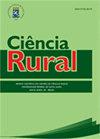Potassium fertilization as salt stress attenuator in sour passion fruit
IF 0.9
4区 农林科学
Q3 AGRONOMY
引用次数: 0
Abstract
ABSTRACT: Water scarcity associated with irregular rainfall in the semi-arid region of Northeastern Brazil stands out as a limiting factor for agricultural production. Thus, the use of waters with high concentration of salts is an alternative to expand irrigated agriculture in this region. In this context, this study evaluated the water status, intercellular electrolyte leakage, photosynthetic pigments, and gas exchange of ‘BRS SC1’ sour passion fruit as a function of irrigation with water of different levels of salinity and potassium doses. The experiment was carried out in pots adapted as drainage lysimeters under field conditions at the Experimental Farm of the Federal University of Campina Grande in São Domingos - PB, Brazil. The experimental design was randomized blocks, in a 5 × 4 factorial scheme, whose treatments were obtained by combining two factors: five levels of electrical conductivity of irrigation water - ECw (0.3, 1.1, 1.9, 2.7, and 3.5 dS m-1), associated with four potassium doses (60, 80, 100, and 120% of the recommendation), with three replicates. Water with electrical conductivity greater than 0.3 dS m-1 reduced the relative water content, chlorophyll a and chlorophyll b contents, CO2 assimilation rate, and instantaneous water use efficiency of ‘BRS SC1’ sour passion fruit plants. The estimated potassium dose of 85% of the recommendation (equivalent to 293 g per plant per year) mitigated the deleterious effects of salt stress on stomatal conductance, transpiration, internal CO2 concentration, and instantaneous carboxylation efficiency of passion fruit ‘BRS SC1’.钾肥对酸性百香果盐胁迫的衰减作用
摘要:巴西东北部半干旱地区降雨不规律导致水资源短缺,这是制约农业生产的重要因素。因此,使用高浓度盐的水是扩大该地区灌溉农业的另一种选择。在此背景下,本研究评估了“BRS SC1”酸味百香果在不同盐度和钾剂量灌溉下的水分状况、细胞间电解质泄漏、光合色素和气体交换。试验在巴西 o多明戈斯- PB联邦坎皮纳格兰德大学实验农场的田间条件下进行。试验设计采用随机分组,采用5 × 4因子方案,通过结合两个因素获得处理方案:灌溉水电导率的5个水平- ECw(0.3、1.1、1.9、2.7和3.5 dS - m-1),与4种钾剂量(推荐剂量的60、80、100和120%)相关,有3个重复。电导率大于0.3 dS m-1的水降低了‘BRS SC1’酸性百香果植株的相对含水量、叶绿素a和叶绿素b含量、CO2同化速率和瞬时水分利用效率。估计钾剂量为推荐剂量的85%(相当于每株每年293 g)减轻了盐胁迫对百香果BRS SC1气孔导度、蒸腾、内部CO2浓度和瞬时羧化效率的有害影响。
本文章由计算机程序翻译,如有差异,请以英文原文为准。
求助全文
约1分钟内获得全文
求助全文
来源期刊

Ciencia Rural
AGRONOMY-
CiteScore
1.70
自引率
0.00%
发文量
233
审稿时长
2-4 weeks
期刊介绍:
The purpose of Ciência Rural is to publish the results of original research, note and reviews which contribute significantly to knowledge in Agricultural Sciences. Preference will be given to original articles that develop news concepts or experimental approaches and are not merely repositories of scientific data. The decison of acceptance for publication lies with the Editors and is based on the recommendations of Editorial Comission, Area Committee and/ or ad hoc reviewers. The editors and reviewers are external to the institution.
 求助内容:
求助内容: 应助结果提醒方式:
应助结果提醒方式:


